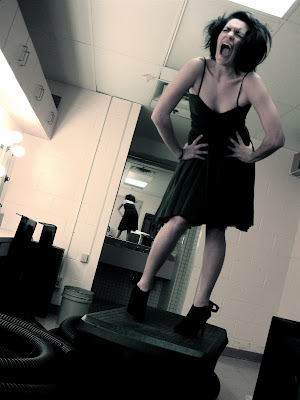 The Demetrius Klein Dance Company’s Accepting Perfect
The Demetrius Klein Dance Company’s Accepting Perfectexplores the frustrations and fulfillments of love.
By Sharon McDaniel
LAKE WORTH – The Klein Dance Studio is a sure-fire source of the thoughtful, the uplifting and the new in modern dance.
But it took a visit to Lake Worth last month by the likes of international choreographer Bill T. Jones and company to jog the memory of just how cutting-edge Lake Worth’s own Demetrius Klein and company are.
Sunday night’s performance marked a milestone, the end of Klein Dance Company’s 20th season. Held at the Lake Avenue studio, the program comprised the Florida premiere of Klein’s dance-theater work Accepting Perfect. The full-length ballet traces the journey we go through looking for that one perfect someone.
Klein, in his notes on the ballet, asks: “Ever made a list of qualifications for your perfect partner? What if you met someone who was perfect for you, but who did not meet any of the qualifications on your list?” The aim is to question and find personal answers for the customary thoughts and images about love and perfection that society throws at us.
The 60-minute work alternated scenes of the dancers speaking — one-liners and quips to Scripture verses – and performing Klein’s bold brand of modern dance. Providing the narrative for the ballet were eight contemporary Christian and rock songs. In Act I, song texts spelled out a familiar blueprint: loneliness to newfound love to love lost. Appreciative applause followed most scenes. Act II was love found, treasured, prayed-for and praised.
The dramatic action began with an effective optical illusion. Faces of the five Klein Dance Company members were dimly lit, giving off a pale, almost ghostly glow. Then in the full stage lighting, three women and two men stood dressed in street clothes, even to footwear of spike heels to boots.
Each person was an island, face buried in a personal cellphone screen. They were slowly drawn out of their isolation as, one at a time, they defined love, speaking the verses of I Corinthians 13, from “Love is patient” to “Love never fails.”
Klein got them moving slowly with hints of popular social dances – remember the ‘60s fad, the Watusi? But the action picked up and the dancers stripped down, revved by Jet’s Are You Gonna Be My Girl. At first, they moved in unison, each on that singular path of finding The One. Indeed, by Marcy Playground’s Sex and Candy, two couples had hooked up.
But they took separate routes – one to bonding, one to break-up — through Klein’s athletic, expressive vocabulary. Leaps were flights of freedom. Falls to the floor and hand slaps on the mat rang loudly through the studio. Rough-and-tumble partnering could take on the look of strong-arming or bear hugs. Even basic ballet-barre exercises turned into signs of personality and attitude.
The troupe ate up every inch of floor space in fast moves and gymnastics. Yet small gestures – finger painting, angular torso contractions, softly arched backs – also spoke persuasively of compelling emotional states.
Dancer Andrea Ollarvide soloed to Ben Folds’ Brick. Her lovely long-held balances and stretches created statue-like stillness, greatly intensifying lyrics such as “now that I’ve found someone I’m feeling more alone.”
Another tremendous solo starred Kori Epps in Aaron Neville’s Tell It Like It Is. Her dejection after a harsh snub by partner Christopher Plunkett gave this torch song a poignant face and all-too-clear body language.
But recovery was just around the corner. The bounce-back looked like an all-out forget-your-troubles beach party. The company let it all out to a particularly upbeat (I Never Promised You) A Rose Garden.
Dancers Stephanie McCluney and Justin Walker were the tag-team couple in Shirley Ellis’ The Nitty Gritty. Theirs was not so much a relationship as a competition. Later, tightly wrapped around each other, they danced an especially tender pas de deux of joy and caring to the Dave Matthews Band’s Crash Into Me.
Act II consisted of three vocal versions of the Leonard Cohen tune Hallelujah. The first featured a dance trio in gestures and movements so small that the three barely moved from center stage. Their introverted motions of personal expression looked even more vulnerable when done in unison.
A quartet followed in a repeated sequence of steps that traveled through sorrow to comfort and reassurance. It was set to the most dramatic version of Hallelujah, sung by Allison Crowe.
The full quintet came together for the finale that combined not only small mime and sign language from sacred dance, but also the biggest, most athletic action of the three variations. The five molded into one in a closed circle, where calm replaced striving and the spiritual overshadowed the physical.